tires MERCEDES-BENZ M-Class 2012 W166 Owner's Guide
[x] Cancel search | Manufacturer: MERCEDES-BENZ, Model Year: 2012, Model line: M-Class, Model: MERCEDES-BENZ M-Class 2012 W166Pages: 396, PDF Size: 14.48 MB
Page 354 of 396
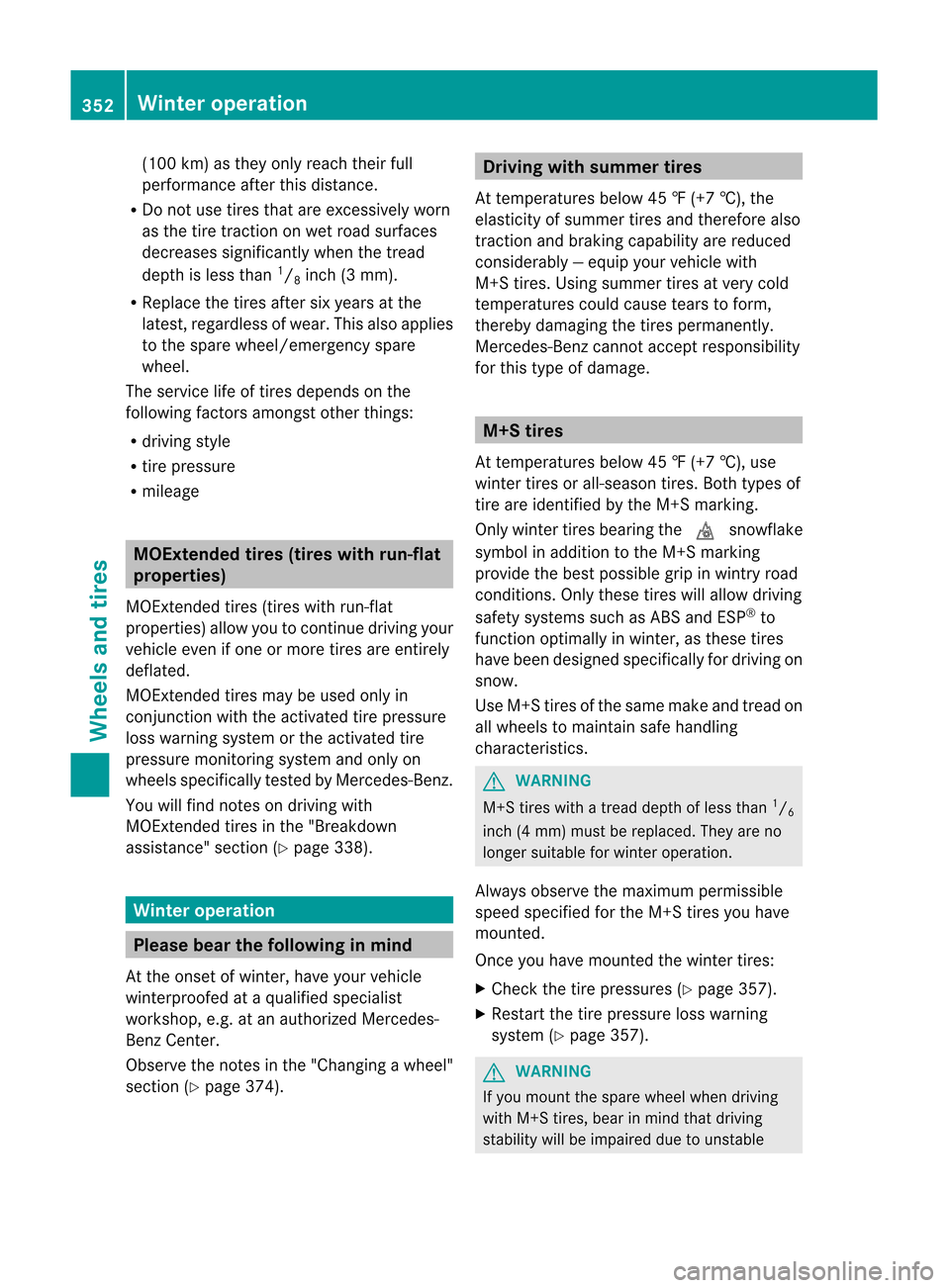
(100
km)as they onlyreach theirfull
perfo rmanceafter thisdistan ce.
R Do not use tiresthat areexcessively worn
as the tire tract ion onwet road surfac es
decr eases significantlywhen thetread
depth isless than 1
/ 8 inc
h(3 mm).
R Replace thetiresafter sixyears atthe
latest ,regardles sof wear. Thisalso applies
to the spare wheel/em ergencyspare
wheel.
The servicelife oftire sdepends onthe
followin gfact orsamong stothe rthings:
R driving style
R tire pressure
R mileage MOExtended
tires(tires withrun-flat
proper ties)
MOExt ended tires(tires withrun-flat
properties) allowyoutocont inue driving your
vehicle evenifone ormore tiresareentirely
deflated.
MOExt ended tiresmaybeused onlyin
conj unction withtheactivated tirepressure
loss warning systemorthe activated tire
pressure monitorin gsystem andonly on
wheels specifically testedbyMercedes-Ben z.
You willfind notes ondriving with
MOExt ended tiresinthe "Breakdown
assistance" section(Ypage 338). Winter
operation Please
bearthefollow inginmind
At the onset ofwinter, haveyourvehicle
winterproofed ataqual ified specialist
workshop, e.g.atan authorized Mercedes-
Benz Center.
Observe thenotes inthe "Cha nging awheel"
section (Ypage 374). Driving
withsumm ertires
At temperatures below45‡(+7 †), the
elasticity ofsummer tiresandtherefore also
tract ionand braking capabilityare reduced
considerably —equip your vehicle with
M+S tires.Using summer tiresatvery cold
temper aturescouldcause tearstoform ,
ther eby damaging thetires perman ently.
Mercede s-Benz cann otaccept responsibility
for this type ofdamage. M+S
tires
At temper aturesbelow45‡(+7 †), use
winter tiresorall-season tires.Both types of
tire areidentified bythe M+S marking.
Only winter tiresbearing thei snowflake
symbol inaddition tothe M+S marking
provide thebest possible gripinwintry road
condit ions.Onlythese tireswillallow driving
safety systems suchasABS andESP®
to
funct ionoptimally inwinter, asthese tires
have been designed specifically fordriving on
snow.
Use M+S tiresofthe same make andtread on
all wheels tomaintain safehandling
charact eristics. G
WARNIN
G M+S
tireswithatread depth ofless than 1
/ 6
inch (4mm) must bereplaced. Theyareno
longer suitable forwinter operation.
Always observe themaximum permissible
speed specified forthe M+S tiresyouhave
mounted.
Once youhave mounted thewinter tires:
X Check thetire pressures (Ypage 357).
X Restart thetire pressure losswarning
system (Ypage 357). G
WARNIN
G If
you mount thespare wheel whendriving
with M+S tires, bearinmind thatdriving
stability willbeimpaired duetounstable 352
Winter
operationWheels and tires
Page 355 of 396
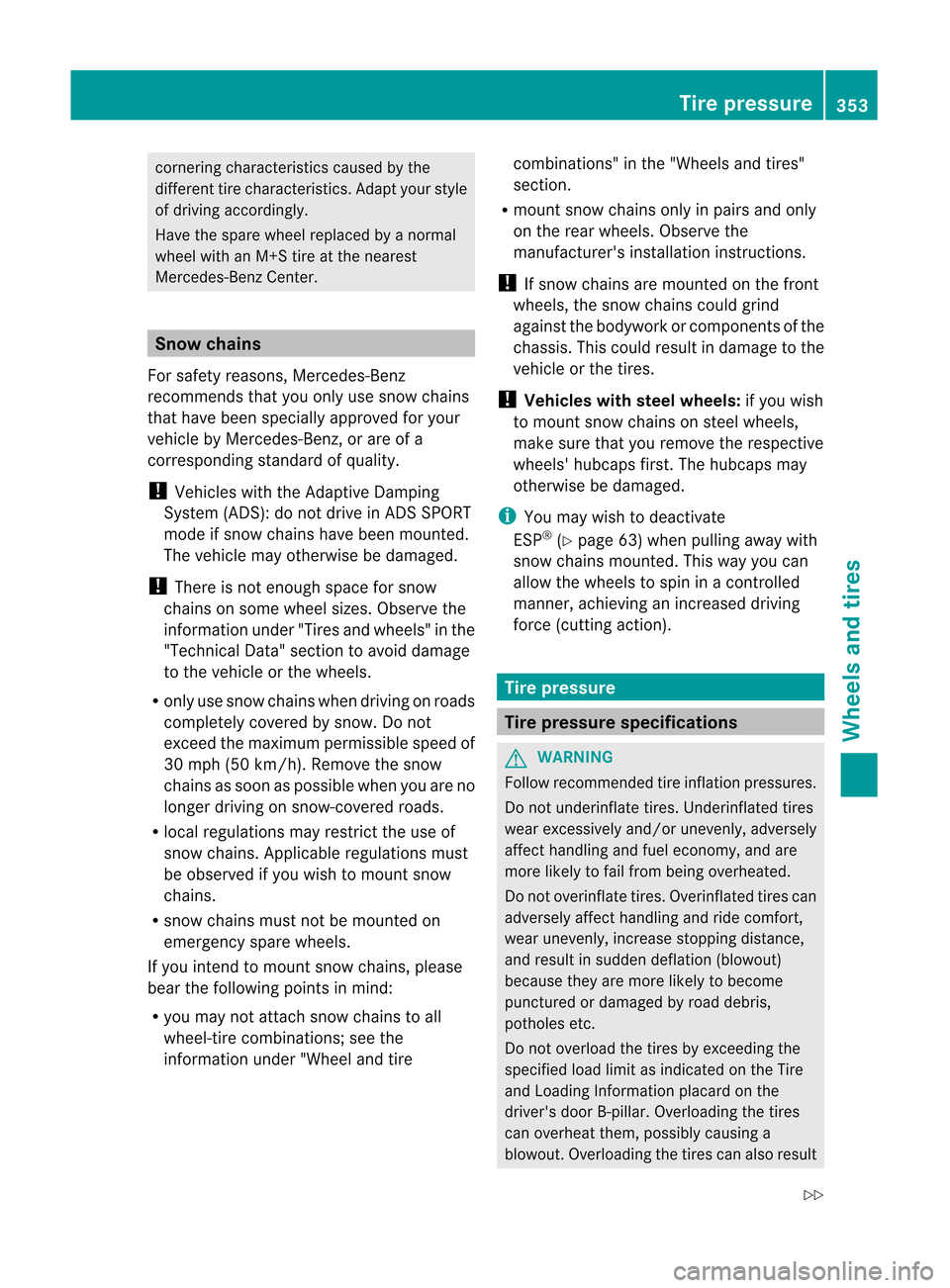
corner
ingcharacte ristics caused bythe
di ffere nttire characte ristics. Adaptyour styl e
of dri ving acco rdingly .
Have thesparewhe elrep laced byanorma l
whe elwith an M+S tireatthe nearest
Merce des-Benz Center. Sno
wchai ns
For safety reasons, Merce des-Benz
recom mends thatyouonly usesnow chains
that have bee nspecially approved foryour
vehicle byMercede s-Benz ,or are ofa
corr espondin gstan dard ofquality.
! Vehicles withtheAdapt iveDampin g
Syst em(ADS):donot drive inAD SSPORT
mode ifsnow chains havebeen mount ed.
The vehicle mayother wisebedamaged.
! There isnot enough spaceforsnow
chains onsome wheel sizes.Observ ethe
infor mation under"Tiresandwheels" inthe
"Techn icalData"sect iontoavoid damage
to the vehicle orthe wheels.
R only usesnow chains whendrivingon roads
complet elycover edbysnow. Donot
exc eed themaximum permissible speedof
30 mph (50km/ h).Remove thesnow
chains assoon aspossible whenyouareno
longer drivingon snow- coveredroads.
R local regulation smay restrict theuse of
snow chains .Applicable regulation smust
be observed ifyou wish tomount snow
chains .
R snow chains mustnotbemount edon
emergen cyspare wheels.
If you intend tomount snowchains ,please
bear thefollowing pointsin mind:
R you may notattach snow chains toall
wheel-t irecombin ations;see the
infor mation under"Wheel andtire combin
ations"in the "Wheels andtires "
sect ion.
R mount snowchains onlyinpairs andonly
on the rear wheels. Observethe
manufacturer's installationinstructions.
! Ifsnow chains aremounted onthe front
wheels, thesnow chains couldgrind
against thebodyw orkorcomponen tsof the
chassis. Thiscould result indamage tothe
vehicle orthe tires.
! Vehicles withsteel wheels :if you wish
to mount snowchains onsteel wheels,
make surethatyouremove therespective
wheels' hubcaps first.Thehubcaps may
otherwise bedamaged. i
You
may wish todeactivate
ESP ®
(Y page 63)when pullingaway with
snow chains mounted. Thiswayyoucan
allow thewheels tospin inacont rolled
manner, achieving anincreased driving
force (cuttin gaction). Tire
pressur e Tire
pressur especific ations G
WARNING Follow
recommen dedtireinflation pressures.
Do not underinflate tires.Underinflated tires
wear excessively and/orunevenly, adversely
affect handling andfuel economy, andare
more likelytofail from being overheated.
Do not overinflate tires.Overinflated tirescan
adversely affecthandling andride comfort ,
wear unevenly, increasestopping distance,
and result insudden deflation (blowout)
because theyaremore likelytobecome
punctured ordamaged byroad debris,
potholes etc.
Do not overload thetires byexceeding the
specified loadlimit asindicated onthe Tire
and Loading Informationplacard onthe
driver's doorB-pillar. Overloading thetires
can overheat them,possibly causinga
blowou t.Overloading thetires canalso result Tire
pressure
353Wheels and tires
Z
Page 356 of 396
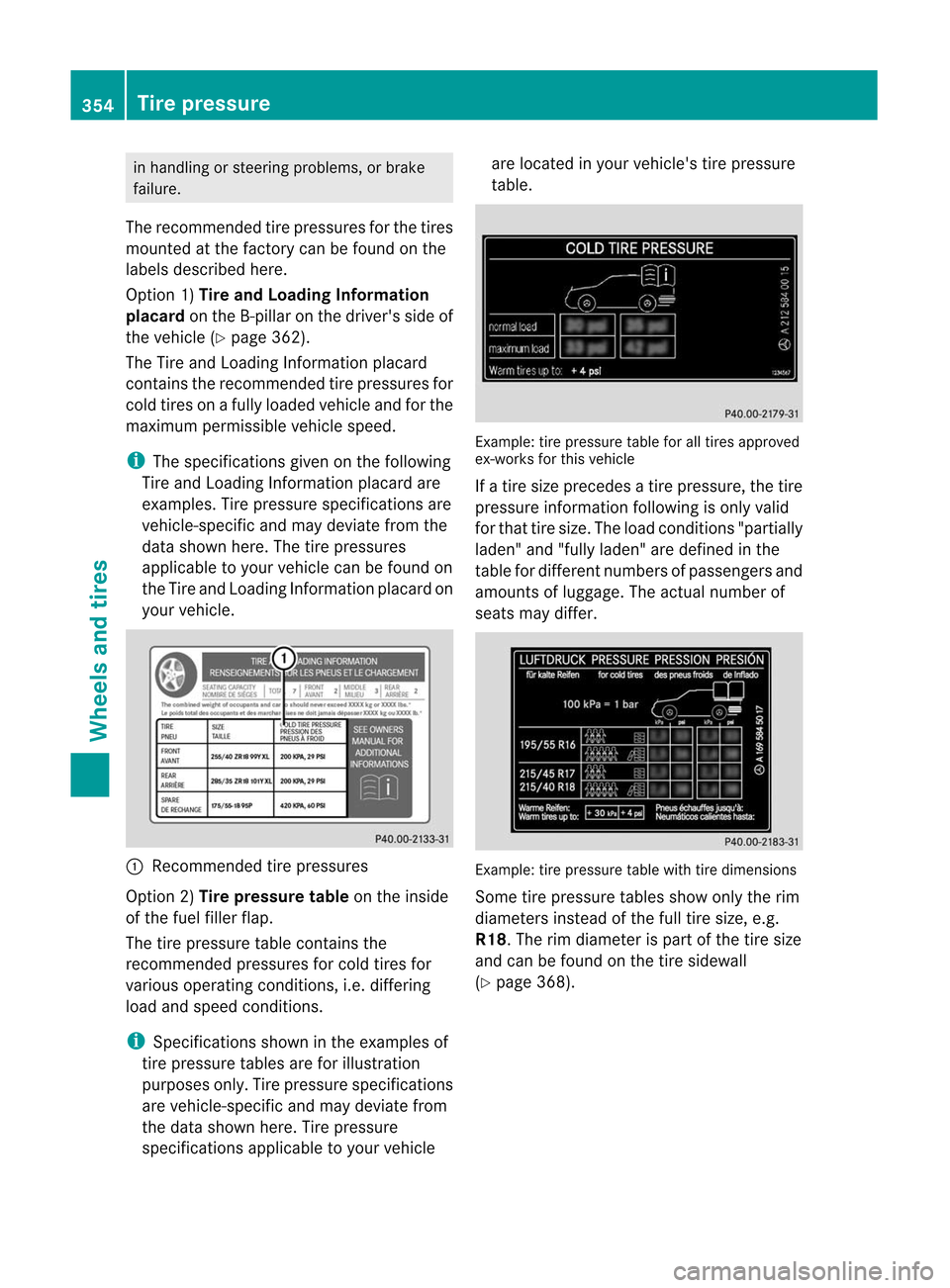
in
handlin gor ste erin gproblem s,or brak e
failure.
The recomme ndedtirepress uresforthe tires
moun tedatthe factorycan befoun don the
labels described here.
Opt ion 1)Tir eand Loadin gInfor mation
pla car don the B-pillar onthe drive r'sside of
the vehic le(Y page 362).
The Tire andLoadin gIn for matio nplacard
con tain sthe recomm endedtir epress uresfor
cold tires on afully loaded vehicleand forthe
maxim umperm issible vehiclespeed. i
The
spec ification sgiven onthe followin g
Tire andLoadin gIn for mat ionplacard are
exam ples.Tirepress urespec ification sare
vehic le-specif icand may deviat efro mt he
data shown here.Thetirepressures
appli cable toyour vehicle canbefound on
the Tire andLoading Informationplacard on
your vehicle. :
Recommended tirepressures
Option 2)Tire pressur etable onthe inside
of the fuel filler flap.
The tirepressure tablecontains the
recommen dedpressures forcold tires for
various operating conditions,i.e. differing
load andspeed condition s. i
Specifications
showninthe examples of
tire pressure tablesareforillustration
purposes only.Tirepressure specifications
are vehicle-specific andmay deviate from
the data shown here.Tirepressure
specifications applicable toyour vehicle are
located inyour vehicle's tirepressure
table. Example:
tirepressure tableforalltires approved
ex-works forthis vehicle
If atire size precedes atire pressure, thetire
pressure information followingisonly valid
for that tiresize. Theload condition s"partiall y
laden" and"fully laden" aredefined inthe
table fordifferent numbers ofpassengers and
amounts oflugga ge.The actual number of
seats maydiffer. Example:
tirepressure tablewithtiredimensions
Some tirepressure tablesshowonlytherim
diameters insteadofthe fulltire size, e.g.
R18. Therimdiameter ispart ofthe tire size
and canbefound onthe tire sidewa ll
(Y page 368). 354
Tire
pressureWheels and tires
Page 357 of 396
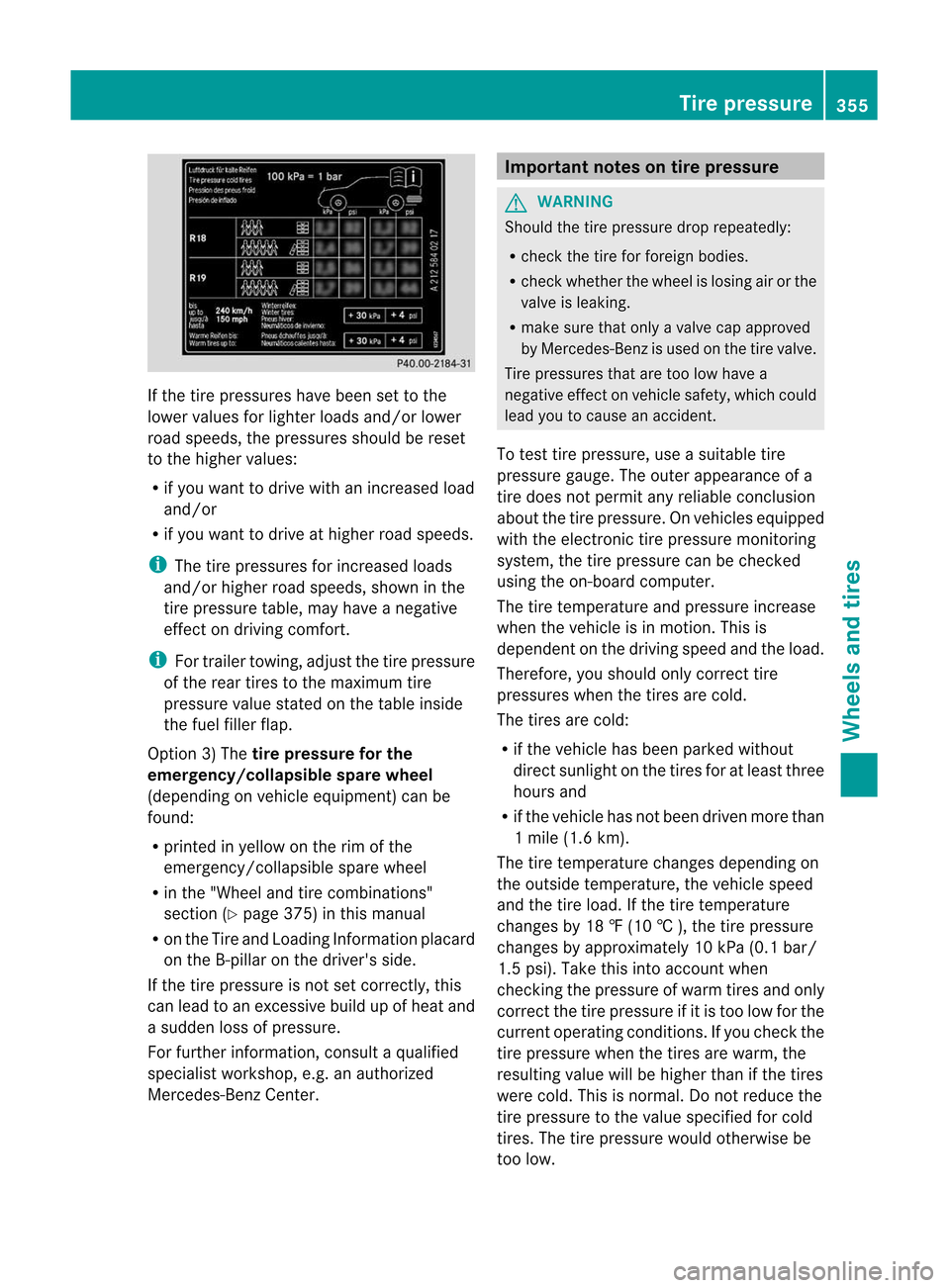
If
the tire pressu reshave been settothe
lowe rvalues forlight erloads and/or lower
road speeds,thepres suressho uld beres et
to thehigh ervalues :
R ifyou want todriv ewit han increas edload
and /or
R ifyou want todriv eat high erroad speeds. i
The
tirepres suresfor increas edloads
and /or high erroad speeds,sho wninthe
tir epres sure table,may have ane gat ive
eff ect ondriv ingcomf ort . i
For
trailer towing ,adj ust thetir epres sure
of therear tires tothemax imum tire
pres sure value state don thet able inside
th efuel fillerflap.
Opt ion 3)The tirepr essur efor the
emer gency/collap siblesparewheel
(depen dingonvehic leequipmen t)can be
foun d:
R prin tedinyellow onthe rim ofthe
emer gency/c ollapsible sparewheel
R in the "Wheel andtirecom binat ions"
sect ion(Ypage 375)in this manual
R on the Tire andLoadin gIn for mat ionplacard
on the B-pillar onthe drive r'sside.
If the tirepress ureisnot setcorrectly, this
can lead toan exc essiv ebuild upofheat and
a sudde nloss ofpressure.
For further information,consult aquali fied
specialist workshop, e.g.anauthorized
Mercedes-B enzCenter. Import
antnotes ontire pressur e G
WARNIN
G Should
thetire pressure droprepeatedly:
R check thetire forforeign bodies.
R check whether thewheel islosing airorthe
valve isleaking.
R make surethatonly avalve capapproved
by Mercedes-B enzisused onthe tire valve.
Tire pressures thataretoo low have a
negative effectonvehicle safety,whichcould
lead youtocause anaccident .
To test tirepressure, useasuitable tire
pressure gauge.Theouter appearance ofa
tire does notpermit anyreliable conclusion
about thetire pressure. Onvehicles equipped
with theelectron ictire pressure monitoring
system, thetire pressure canbecheck ed
using theon-board computer.
The tiretemperat ureand pressure increase
when thevehicle isin motion .This is
dependent onthe driving speedandtheload.
Therefore, youshould onlycorrect tire
pressures whenthetires arecold.
The tires arecold:
R ifthe vehicle hasbeen parked without
direct sunlight onthe tires foratleast three
hours and
R ifthe vehicle hasnotbeen driven morethan
1 mile (1.6km).
The tiretemperature changesdepending on
the outside temperature, thevehicle speed
and thetire load. Ifthe tire temperature
changes by18 ‡(10 †),the tire pressure
changes byapproximately 10kPa (0.1 bar/
1.5 psi). Take thisinto account when
check ingthe pressure ofwarm tiresandonly
correct thetire pressure ifit is too low forthe
current operating conditions.Ifyou check the
tire pressure whenthetires arewarm, the
resulting valuewillbehigher thanifthe tires
were cold.Thisisnormal. Donot reduce the
tire pressure tothe value specified forcold
tires. Thetirepressure wouldotherwise be
too low. Tire
pressure
355Wheels and tires Z
Page 358 of 396

Observe
therecommended tirepressures for
cold tires
R on the Tire andLoading Information placard
on the B-pillar onthe driver's side,
R in the tire pressure tableonthe inside of
the fuel filler flap,
R printed inyell ow onthe rim ofthe
emergency/collapsib lespare wheel
(depending onvehicle equipment). Underinflated
oroverinflated tires
Underinflated tires G
WARNING Follow
recommended tireinflation pressures.
Do not underinflate tires.Underinflated tires
wear excessively and/orunevenly, adversely
affect handling andfuel economy, andare
more likelytofail from being overheated.
Underinflated tirescan:
R wear excessively and/orunevenly
R adversely affectfueleconomy
R fail from being overheated
R adversely affecthandling
Overinflated tires G
WARNING Follow
recommended tireinflation pressures.
Do not overinflate tires.Overinflated tirescan
adversely affecthandling andride comfort ,
wear unevenly, increasestopping distance,
and result insudden deflation (blowout)
because theyaremore likelytobecome
punctured ordamaged byroad debris,
potholes etc.
Overinflated tirescan:
R adversely affecthandling
R wear excessively and/orunevenly
R be more likelytobecome damaged R
adversely affectridecomfort
R increase stopping distance
Maximum tirepressure G
WARNING Never
exceed themaximum tireinflation
pressure. Followrecommended tireinflation
pressures.
Do not underinflate tires.Underinflated tires
wear excessively and/orunevenly, adversely
affect handling andfuel economy, andare
more likelytofail from being overheated.
Do not overinflate tires.Overinflated tirescan
adversely affecthandling andride comfort ,
wear unevenly, increasestopping distance,
and result insudden deflation (blowout)
because theyaremore likelytobecome
punctured ordamaged byroad debris,
potholes etc. :
Maximum permittedtirepressure
(example) i
The
actual valuesfor tires arespecific to
each vehicle andmay deviate fromthe
value sin the illustration.
When adjusting thetire pressures always
observe therecommended tirepressure for
your vehicle (Ypage 353). 356
Tire
pressur eWheels and tires
Page 359 of 396
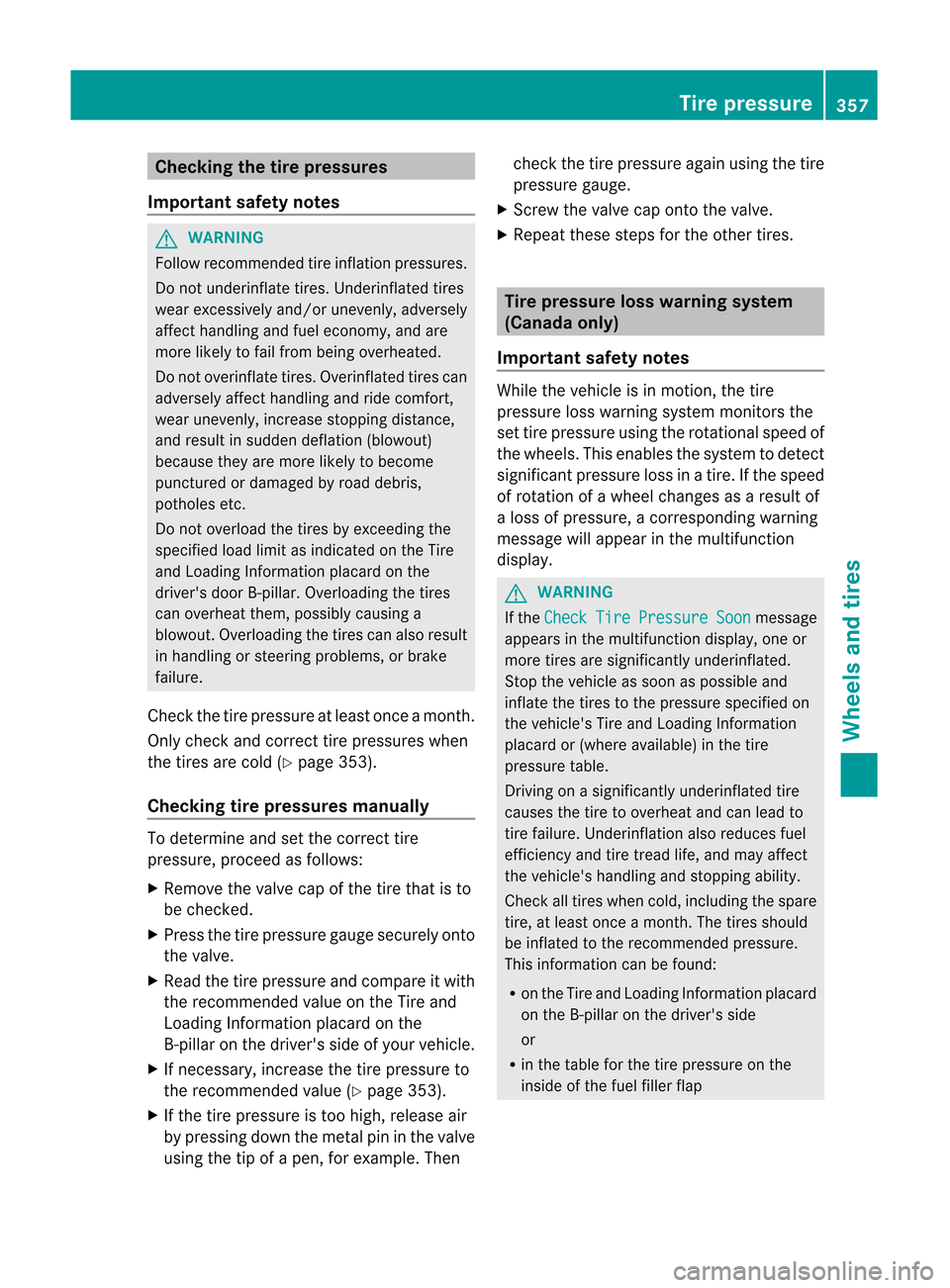
Check
ingthetir epr essu res
Imp ortant safety notes G
WAR
NING Fol
low recomm ended tireinf lati onpres sures.
Do notunde rinflat etir es. Underi nflate dtir es
wear exces sively and /or unevenly,adve rsely
aff ect handlingand fuel economy, and are
mor elik ely tofail from bein gove rheated.
Do notoverinfla tetires. Overinfla tedtires can
adve rsely affect handlingand ride comfort,
wea runeve nly,incre asestop ping dista nce,
and resulti ns udden deflation (blowo ut)
bec ause they are mor elik ely tobec ome
pun ctured ordamag edbyroad debris,
pot hole set c.
Do noto verloa dthe tires byexceedi ngthe
specifi edloadlimi tasindicated onthe Tire
and Loading Information placardonthe
driver's doorB-pillar. Overloading thetires
can overheat them,possibly causinga
blowou t.Overloading thetires canalso result
in handling orsteering problems, orbrake
failu re.
Check thetire pressure atleast once amonth.
Only check andcorrect tirepressures when
the tires arecold (Ypage 353).
Checki ngtire pressures manually To
determine andsetthe correct tire
pressure, proceedasfollows:
X Remove thevalve capofthe tire that isto
be checked.
X Press thetire pressure gaugesecurely onto
the valve.
X Read thetire pressure andcompare itwith
the recommended valueonthe Tire and
Loading Information placardonthe
B-pillar onthe driver's sideofyour vehicle.
X Ifnecessary, increasethetire pressure to
the recommended value(Ypage 353).
X Ifthe tire pressure istoo high, release air
by pressing downthemetal pininthe valve
using thetipofapen, forexample. Then check
thetire pressure againusing thetire
pressure gauge.
X Screw thevalve caponto thevalve.
X Repea tthese steps forthe other tires. Tire
pressur eloss warning system
(Canada only)
Import antsafety notes While
thevehicle isin motion, thetire
pressure losswarning systemmonitors the
set tire pressure usingtherotational speedof
the wheels. Thisenables thesystem todetect
significant pressurelossinatire. Ifthe speed
of rotation ofawheel changes asaresult of
a loss ofpressure, acorresponding warning
message willappea rint he multifunction
displa y. G
WARNING If
the Check Tire Pressure Soon message
appears inthe multifunction display,one or
more tiresaresignificantly underinflated.
Stop thevehicle assoon aspossible and
inflate thetires tothe pressure specified on
the vehicle's TireandLoading Information
placard or(where available)inthe tire
pressure table.
Driving onasignificantly underinflated tire
causes thetire tooverheat andcanlead to
tire failure. Underinflation alsoreduces fuel
efficiency andtiretread life,and may affect
the vehicle's handlingandstopping ability.
Check alltires when cold,including thespare
tire, atleast once amont h.The tires should
be inflated tothe recommen dedpressure.
This information canbefound:
R on the Tire andLoading Informationplacard
on the B-pillar onthe driver's side
or
R in the table forthe tire pressure onthe
inside ofthe fuel filler flap Tire
pressure
357Wheels and tires Z
Page 360 of 396
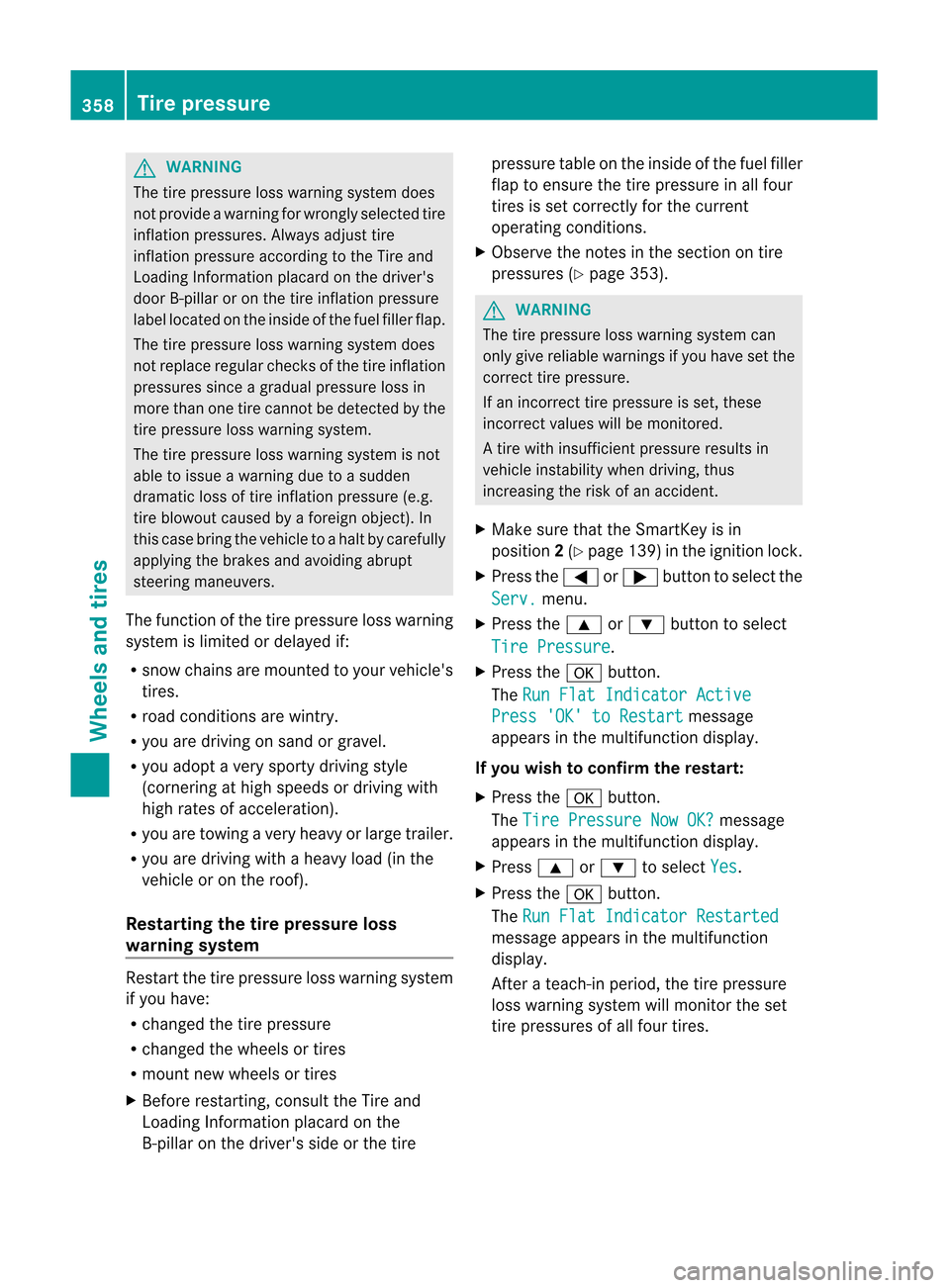
G
WARNING The
tirepressu reloss warni ngsystem does
not provid eawar ning forwrongl ysele cted tire
infla tion pressu res.Alwa ysadju sttire
infla tion pressu reaccordi ngtothe Tire and
Load ingInformation placard onthe drive r's
door B-pillaror on the tire infla tion pressu re
lab elloca tedonthe insid eof the fuel filler flap .
The tirepressu reloss warni ngsystem does
not repl ace regu larchecks ofthe tire infla tion
pressu ressince agrad ualpressu reloss in
more thanonetirecannot bedetected bythe
tire pressu reloss warning system.
The tirepressu reloss warni ngsystem isnot
abl eto issu eawar ning duetoasud den
drama ticloss oftire infla tion pressu re(e.g.
tire blow outcaus edbyaforeig nobjec t).In
this case bring thevehicle toahalt bycarefully
applying thebrakes andavoiding abrupt
steer ingmaneuver s.
The func tionofthe tire pressure losswarning
system islimited ordelayed if:
R snow chains aremount edtoyour vehicle's
tires.
R road condition sare wintr y.
R you aredriving onsand orgravel.
R you adopt avery sport ydriving style
(corn ering athigh speeds ordriving with
high rates ofaccelerat ion).
R you aretowing avery heavy orlarge trailer.
R you aredriving withaheavy load(inthe
vehicle oron the roof).
Resta rting the tirepr essure loss
warning system Restart
thetire pressure losswarning system
if you have:
R chang edthe tire pressure
R chang edthe wheels ortires
R mount newwheels ortires
X Befor erest artin g,con sult theTire and
Loading Informat ionplacard onthe
B- pillar onthe driver's sideorthe tire pressure
tableonthe inside ofthe fuel filler
flap toensure thetire pressure inall four
tires isset corr ectlyfor the curren t
operatin gcon dition s.
X Observe thenotesinthe sect ionontire
pressures (Ypage 353). G
WARN
ING The
tirepressure losswarning systemcan
only givereliable warning sif you have setthe
corr ecttire pressure.
If an incor recttirepressure isset, these
incor rectvalues willbemonit ored.
At ire with insufficientpress ureresult sin
vehic leinst ability whendriving,thus
inc reasin gthe risk ofan acc ident .
X Make surethattheSmartKey isin
posit ion2(Y page 139)int he ignition lock.
X Press the= or; button toselect the Serv. menu.
X Press the9 or: button toselect Tire
Pressure .
X Press thea button.
The Run
Flat Indicator Active Press
'OK'toRestart message
appea rsinthe multifunction display.
If you wish toconfirm therestar t:
X Press thea button.
The Tire
Pressure NowOK? message
appea rsinthe multifunction display.
X Press 9or: toselect Yes .
X Press thea button.
The Run
Flat Indicator Restarted message
appearsinthe multifunction
displa y.
Aft erateach-in period,thetire pressure
loss warning systemwillmonitor theset
tire pressures ofall four tires. 358
Tire
pressureWheels and tires
Page 361 of 396
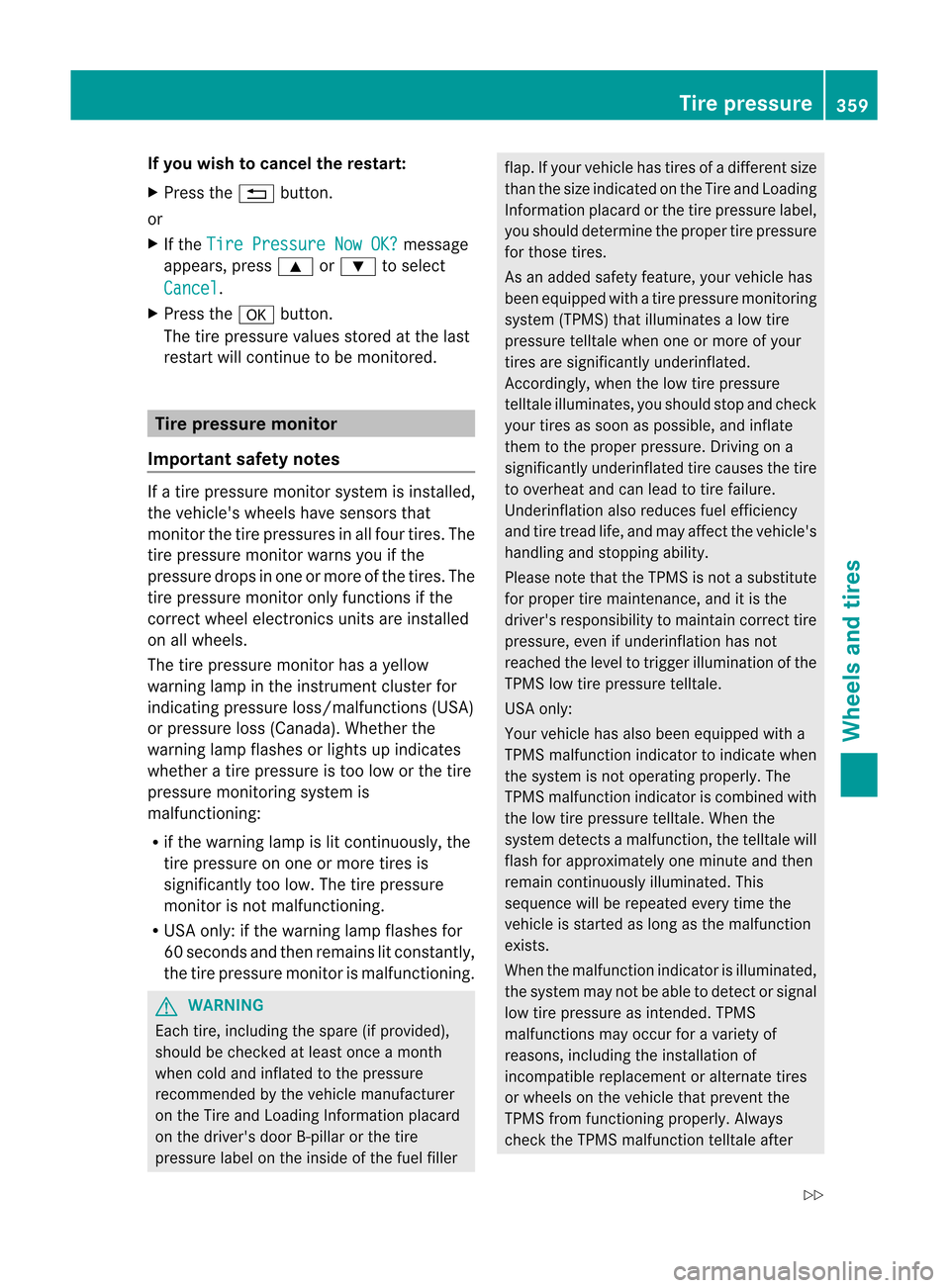
If
you wish tocancel theres tart:
X Pre ssthe% button.
or
X Ifth e Tir
ePre ssureNow OK? mes
sage
appear s,pre ss9 or: tosele ct Can
cel .
X Pre ssthea button.
The tirepre ssur evalues store dat thelast
res tartw illcon tinue tobe mon itored. Tir
epr essur emonit or
Imp ortant safety notes If
atir epress uremon itorsyst emisinst alled,
the vehic le'swheels havesensors that
mon itorthetirepress uresinall four tires. The
tir epress uremon itorwarns youifthe
press uredrops inone ormor eof the tires. The
tir epress uremon itoronly functionsif the
cor rectwheel electronic sunits areinstalled
on allwheels.
The tirepressure monitorhasayell ow
warning lampinthe instrumen tcluster for
indicating pressureloss/malfunction s(USA)
or pressure loss(Canada ).Whether the
warning lampflashes orlights upindicates
whether atire pressure istoo low orthe tire
pressure monitorin gsystem is
malfunctionin g:
R ifthe warning lampislit cont inuously ,the
tire pressure onone ormore tiresis
significantly toolow. Thetirepressure
monitor isnot malfunctionin g.
R USA only: ifthe warning lampflashes for
60 seconds andthen remains litconst antly,
the tire pressure monitorismalfunctionin g. G
WARNING Each
tire,including thespare (ifprovided),
should becheck edatleast once amont h
when coldandinflated tothe pressure
recommen dedbythe vehicle manufacturer
on the Tire andLoading Informationplacard
on the driver's doorB-pillar orthe tire
pressure labelonthe inside ofthe fuel filler flap.
Ifyour vehicle hastires ofadifferent size
than thesize indicated onthe Tire andLoading
Inform ationplacard orthe tire pressure label,
you should determine theproper tirepressure
for those tires.
As anadded safetyfeature, yourvehicle has
been equipp edwith atire pressure monitorin g
system (TPMS)thatilluminates alow tire
pressure telltalewhenoneormore ofyour
tires aresignificantly underinflated.
Acc ordingly, whenthelow tirepressure
telltale illuminates, youshould stopandcheck
your tires assoon aspossible, andinflate
them tothe proper pressure. Drivingona
significantly underinflated tirecauses thetire
to overheat andcanlead totire failure.
Underinflation alsoreduces fuelefficiency
and tiretread life,and may affect thevehicle's
handling andstopping ability.
Please notethattheTPMS isnot asubstitute
for proper tiremaintenanc e,and itis the
driver's responsibility tomaintain correcttire
pressure, evenifunderinflation hasnot
reached thelevel totrigger illumination ofthe
TPMS lowtirepressure telltale.
USA only:
Your vehicle hasalso been equipp edwith a
TPMS malfunction indicatortoindicate when
the system isnot operating properly.The
TPMS malfunction indicatoriscombined with
the low tirepressure telltale.Whenthe
system detects amalfunction, thetelltale will
flash forapproximately oneminute andthen
remain continuously illuminated. This
sequence willberepeated everytimethe
vehicle isstarted aslong asthe malfunction
exists.
When themalfunction indicatorisillu minated,
the system maynotbeable todetect orsignal
low tirepressure asintended. TPMS
malfunctions mayoccur foravariety of
reasons, including theinstallation of
incompatible replacementoralternate tires
or wheels onthe vehicle thatprevent the
TPMS fromfunctioning properly. Always
check theTPMS malfunction telltaleafter Tire
pressure
359Wheels and tires
Z
Page 362 of 396
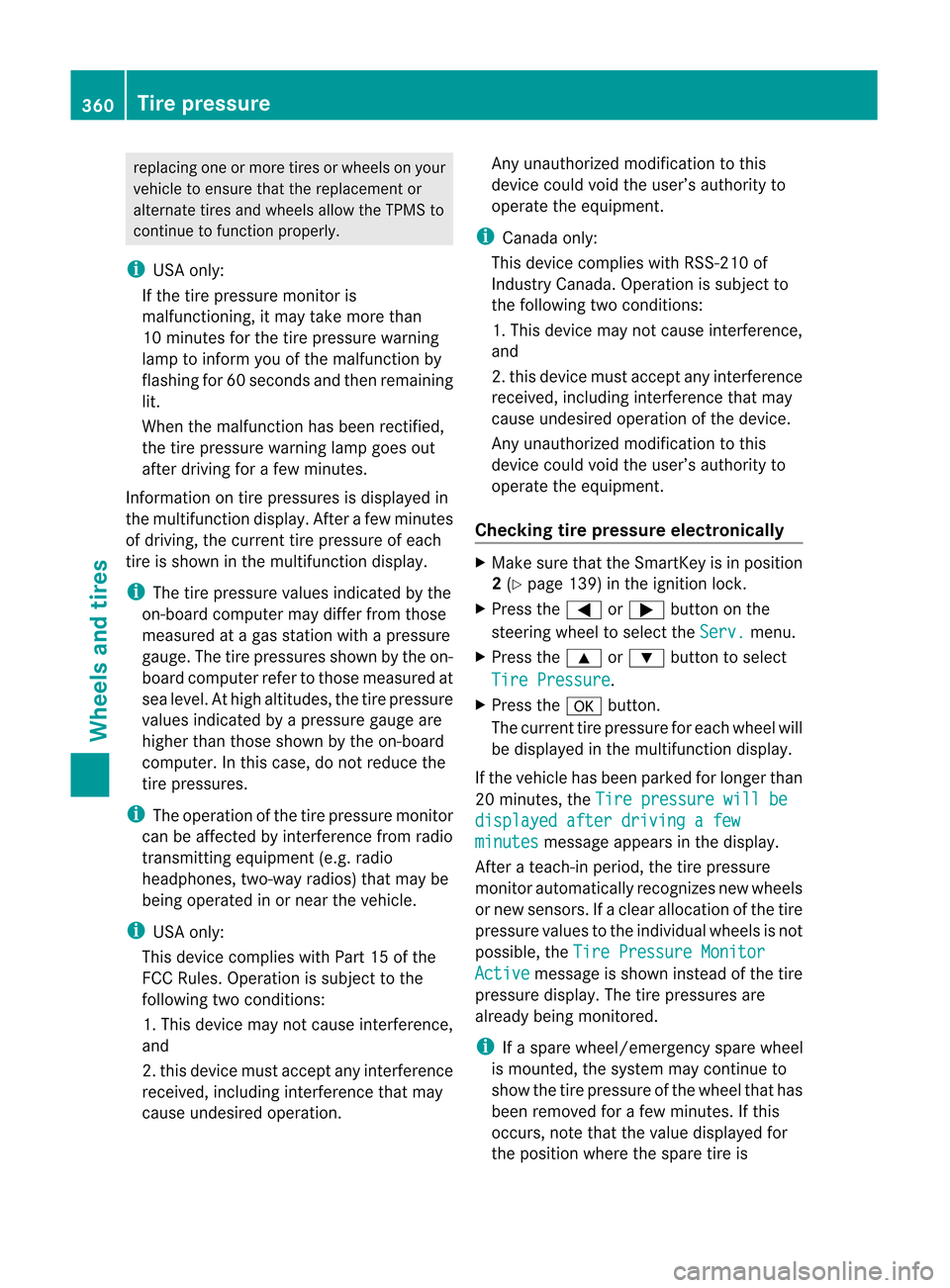
repla
cingoneormore tiresorwhee lson you r
vehicl eto ensure thattherepla cement or
alterna tetires andwhee lsall ow the TPMS to
continue tofunction properly. i
USA
only:
If the tire pressu remonitor is
malfu nctioning, itmay take more than
10 minutes forthe tire pressu rewarni ng
lamp toinform youofthe malfu nction by
flas hing for60seconds andthen remai ning
lit.
When themalfu nction hasbeen rectified ,
the tire pressu rewarni nglamp goesout
after drivingfor afew minutes.
Information ontire pressu resisdisp layed in
the multi function display.After afew minutes
of drivi ng,the current tirepress ureofeach
tire isshow nint he multifunction display. i
The
tirepressure valuesindicated bythe
on-board computer maydiffer fromthose
measured atagas station withapressure
gauge. Thetirepressures shownbythe on-
board computer refertothose measured at
sea level. Athigh altitudes, thetire pressure
values indicated byapressure gaugeare
higher thanthose shown bythe on-board
computer. Inthis case, donot reduce the
tire pressures. i
The
operation ofthe tire pressure monitor
can beaffected byinterfer encefromradio
transmit tingequipment (e.g.radio
headphones, two-wayradios)thatmay be
being operated inor near thevehicle. i
USA
only:
This device complies withPart15ofthe
FCC Rules. Operation issubject tothe
following twocondition s:
1. This device maynotcause interfer ence,
and
2. this device mustaccept anyinterfer ence
received, includinginterferencethatmay
cause undesired operation. Any
unauthorized modificationtothis
device couldvoidtheuser’s authority to
operate theequipment. i
Canada
only:
This device complies withRSS-2 10of
Industry Canada.Operation issubjec tto
the followi ng two cond itions :
1. Thisde vice ma ynot causeinte rferenc e,
and
2. thi sde vice mu stacc eptany inte rference
rece ived,incl uding inte rference thatm ay
caus eunde sired oper ationofthe device.
Any unauthorized modificationtothis
device couldvoidtheuser’s authority to
operate theequipment.
Checking tirepressur eelec tronically X
Make surethattheSmartK eyisin position
2 (Y page 139)inthe ignition lock.
X Press the= or; button onthe
steering wheeltoselect the Serv. menu.
X Press the9 or: button toselect Tire
Pressure .
X Press thea button.
The current tirepressure foreach wheel will
be displa yedinthe multifunction display.
If the vehicle hasbeen parked forlonger than
20 minutes, the Tire
pressure willbe displayed
afterdriving afew minutes message
appearsinthe displa y.
Aft erateach-in period,thetire pressure
monitor automatically recognizesnew wheels
or new sensors. Ifac lear allocat ionofthe tire
press urevalues tothe indiv idual wheels isnot
possible ,the Tire
Pressure Monitor Acti
ve mess
ageisshown instead ofthe tire
press uredisplay. Thetirepress uresare
already beingmonitored. i
If
aspare wheel/ emergencyspare wheel
is moun ted,thesyst emmay continue to
show thetirepress ureofthe wheel thathas
been removedforafew minutes .If this
occ urs, notethat thevalue displayed for
the posit ionwhere thespare tireis 360
Tir
epr essur eWheels and tires
Page 363 of 396
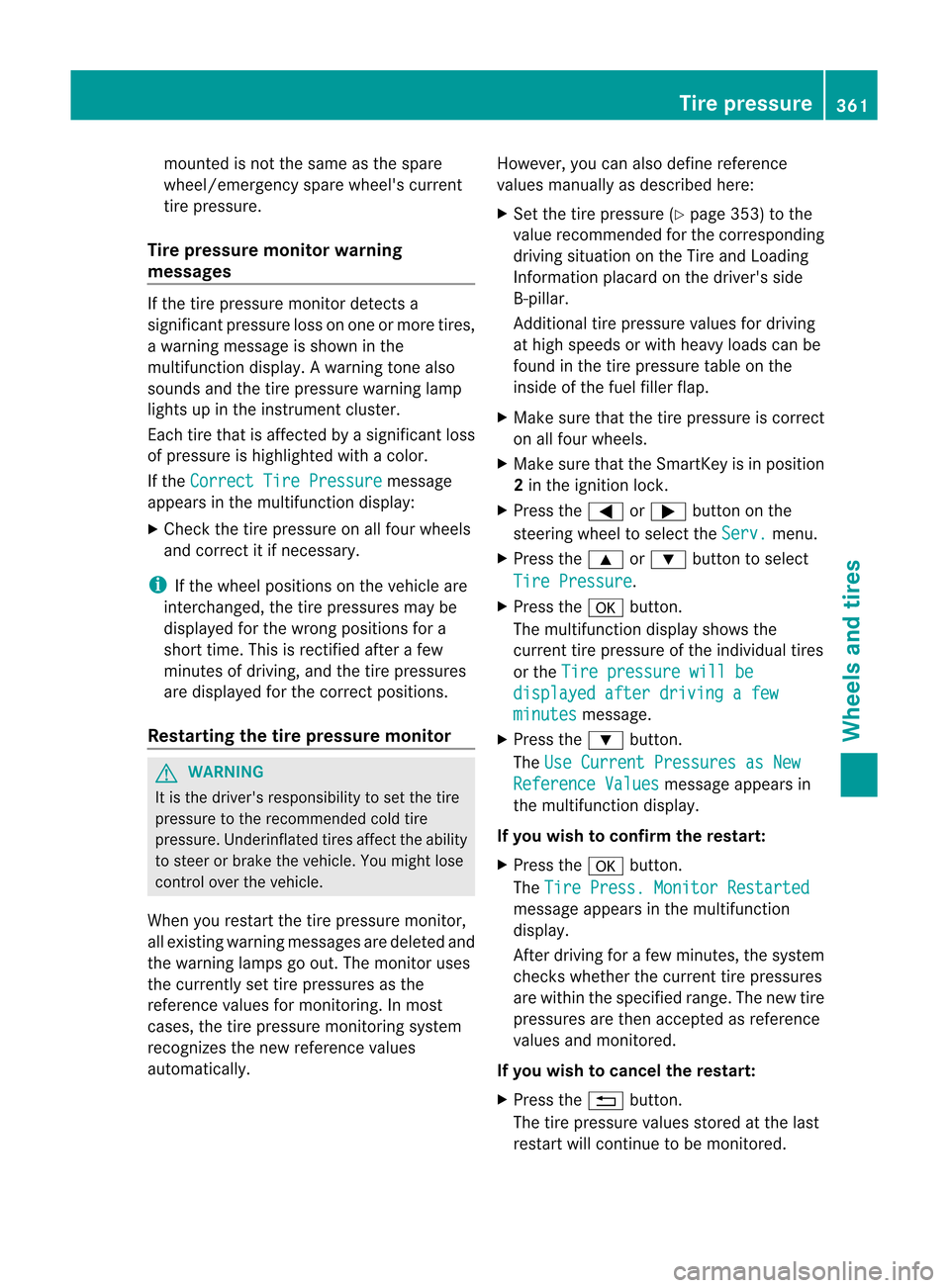
mounted
isnot thesame asthe spare
whee l/emerg encyspare wheel'scurrent
tire pressu re.
Tire pressure monitorwarning
message s If
the tire pressu remonitor detectsa
signifi cantpressu reloss onone ormore tires,
a warni ngmessa geisshow nint he
multifunction display.Aw arning tone also
soun dsand thetir epres sure warninglamp
light sup intheins trumen tcluster .
Eac htir ethat isaffec tedbyasign ificant loss
of press ureishighligh tedwith acolor .
If the Corr
ect Tire Pressure mess
age
appears inthe mult ifunc tiondisplay:
X Check thetirepress ureonallfour wheels
and correctit ifnec essary. i
If
the wheel positionsonthe vehic leare
int erc hang ed,the tirepress uresmaybe
displayed forthe wron gposit ionsfora
shor ttime. Thisisrec tified afterafew
min utes ofdrivin g,and thetirepress ures
are displayed forthe correctpositions.
Restar tingthetire pressur emonitor G
WARNIN
G It
is the driver's responsibility toset the tire
pressure tothe recommen dedcold tire
pressure. Underinflatedtiresaffect theability
to steer orbrake thevehicle. Youmight lose
cont rolover thevehicle.
When yourestart thetire pressure monitor,
all existin gwarning messages aredeleted and
the warning lampsgoout. Themonit oruses
the current lyset tire pressures asthe
referen cevalues formonit oring. Inmost
cases, thetire pressure monitoringsystem
recogn izesthenew referen cevalues
automatically. However,
youcan also define referen ce
values manually asdescribed here:
X Set thetire pressure (Ypage 353)tothe
value recomm endedforthe correspon ding
driving situation onthe Tire andLoading
Infor mation placard onthe driver's side
B-pillar.
Additional tirepressure valuesfordriving
at high speeds orwith heavy loadscanbe
found inthe tire pressure tableonthe
inside ofthe fuel filler flap.
X Make surethatthetire pressure iscorrec t
on allfour wheels.
X Make surethattheSmart Keyisin position
2 in the ignition lock.
X Press the= or; button onthe
steerin gwheel toselect the Serv. menu.
X Press the9 or: button toselect Tire
Pressure .
X Press thea button .
The multifunct iondisplay showsthe
current tirepressure ofthe individual tires
or the Tire
pressure willbe displayed
afterdriving afew minutes message.
X Press the: button .
The Use
Current Pressures asNew Reference
Values message
appearsin
the multifunct iondisplay .
If you wish toconfirm theresta rt:
X Press thea button .
The Tire
Press. Monitor Restarted message
appearsinthe multifunct ion
display .
Aft erdriving forafew minutes, thesystem
check swhether thecurrent tirepressures
are within thespecified range.Thenew tire
pressures arethen accepted asreferen ce
values andmonit ored.
If you wish tocancel theresta rt:
X Press the% button .
The tirepressure valuesstored atthe last
restart willcont inue tobe monit ored. Tir
epr essure
361Wheels and tires Z